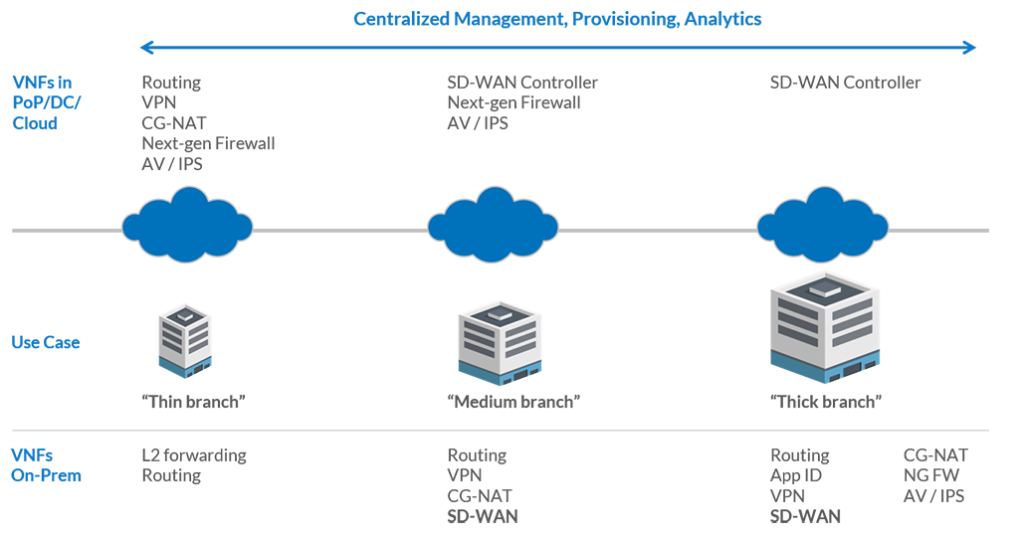Versa Launches New Branch & WAN Architecture

Founder and CDO, Versa Networks
November 10, 2015
 Enterprise WAN and branch architectures really haven’t changed much in the last 20 years. Traffic patterns, though, have changed quite a bit with the advent of cloud apps like Office365 and Salesforce.com. Couple that with large amounts of branch traffic going to recreational sites.
Enterprise WAN and branch architectures really haven’t changed much in the last 20 years. Traffic patterns, though, have changed quite a bit with the advent of cloud apps like Office365 and Salesforce.com. Couple that with large amounts of branch traffic going to recreational sites.
But today’s branch architectures are still designed for branch-to-data center or -HQ connectivity based on expensive MPLS connectivity or DIY over-the-top VPN technologies like DMVPN (which are complex to setup and manage). At the same time, broadband connectivity has significantly improved and its performance metrics are similar to MPLS.
Compounding these WAN issues is the fact that branch architectures are still 100% based on proprietary – and expensive – hardware appliances such as routers, firewalls, WAN optimization controllers, etc. And each has its own management and monitoring systems. Major analyst firms cite the average cost of branch network and security devices ranges from $10,000 to over $50,000, depending on size of branch, bandwidth and connectivity types, and security/compliance requirements.
The simple truth is that both service providers and enterprises are in serious need of an upgrade to the existing WANs and branch office networks they own or manage.
Service providers are facing a multitude of operational and business challenges that hinder their ability to stay competitive in managed services. Foremost are the high Capex due to proprietary hardware components (i.e. CPE and head-end devices) and Opex that seldom align with revenue goals. Time-to-market and service agility are also key issues, as legacy WAN/branch architectures do not lend themselves to rapid service creation and deployment due to the sprawl of proprietary hardware and software to integrate and manage.
Enterprises, whether purchasing managed services or managing their own WANs/branches, have to deal with long provisioning times, high connectivity expenses and the same costly and proprietary networking/security hardware. Additionally, enterprise networks teams are facing increasing demands for agility from DevOps and business stakeholders, whether it’s moving applications or services to the cloud, or increasing security and compliance at the edge of the network (Gartner estimates that by 2016 more than 30% of advanced threats will come from the branch).
Solutions to these problems are in such high demand that the “intelligent” segment of the WAN market is estimated to reach $3.2 billion by 2018 (Doyle Research), while the service provider-enabling NFV market is projected to reach $11.9 billion by 2019 (Infonetics/IHS).
With the launch of Versa Networks, we are working to accelerate the creation of a new generation of WAN and branch architectures. Architectures that will transform how service providers build, deploy and operate managed services. And provide enterprises with much needed cost efficiency and simpler WAN and branch network operations through the ability to completely redesign how they are connected and secured.
Versa is helping service providers and large enterprises achieve these fundamental WAN and branch office redesigns through the intensive innovation we have developed over the last three years to de-couple network and security functions from their underlying hardware platforms – while providing carrier-grade performance and scalability. This Versa innovation is often classified as “virtualized network functions” or VNF, and it is a core component of that $11.6B in 2019 NFV market.
Our vision is to enable a whole new way to design, deploy and operate next-generation WANs/branches and managed services. By allowing providers and enterprises to take a wide set of de-coupled network and security functions and locate them where they best meet business and IT requirements – such as a major bank requiring deep layered security at the branch (e.g. a “thick branch”), while a managed service for SMBs might require minimal functionality at the customer site to minimize cost and complexity, combined with some functions in the telco cloud (e.g. a “thin branch”).


Today we are launching the Company, along with some of the most significant technology advancements – and resulting benefits – for re-architecting WANs in 20+ years:
- Centralized management, orchestration and analyticsthat radically change how WANs and branch networks are deployed, operated and continually optimized
- A fundamental transition from proprietary network and security hardware to virtualized network and security functions (VNF) running on low-cost commodity hardware
- Dynamic multi-path optimization and application-aware routing for a better end user experience and lower connectivity costs
- Up to 80 percent reduction in TCO using software-based VNFs and commodity hardware, combined with multi-tenancy and true zero-touch provisioning
- Reduction in deployment time from months to hours when adding new branches, connections and security functions to the network
Back in 2012 as we started Versa, we saw the need to fundamentally re-draw how WAN and branch networks were architected. Fast-forward nearly three years, lots of agile innovation and 40+ major carrier and enterprise PoCs/trials/production customers, and we have the first glimpse of where today’s WANs and branch networks are heading to – and we think the world’s service providers and large enterprises, after 20+ years, might welcome the change…






